Alex Santoso • Wednesday, September 19, 2007 at 12:01 AM
More than a quarter of all people in the world belong to Eastern religions, which include Buddhism, Hinduism, Sikhism, and Taoism. These people worship in temples, which are architecturally as diverse as the religions are different from each other. From the ancient ruins of Ankor Wat to the distinctly modern Wat Rong Khun, there are hundreds if not thousands of amazing temples in the world.
I have long been fascinated by the temples and sacred sites of Eastern religions. After doing an article on some amazing churches from around the world (10 Divinely Designed Churches), it's only right that we do a follow up on the ten most fascinating temples in Asia. Here they are, in no particular order:
The monastery, formally called Taktshang Goemba, was built in 1692 and reconstructed in 1998 after a fire. Now, the monastery is restricted to practicing Buddhists on religious retreats and is off-limits to ordinary tourists.
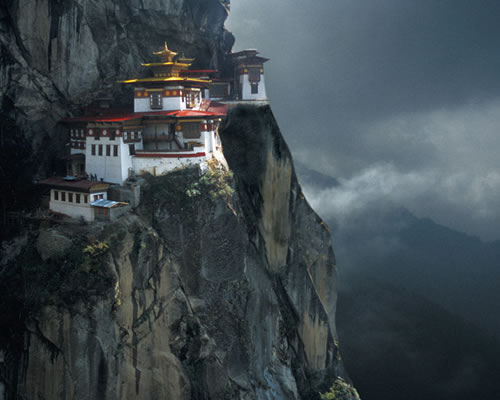
Image: Leo Palmer Photography
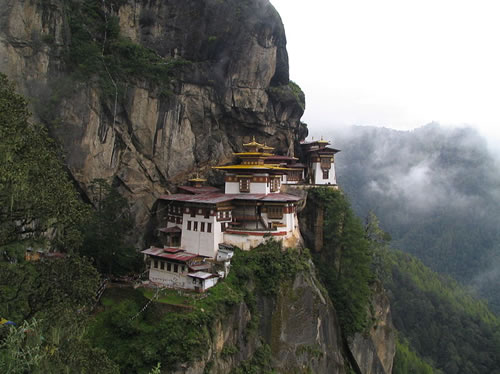
Image: Douglas J. McLaughlin [wikipedia]
Actually, the temple is still under construction. Chalermchai expects it will take another 90 years to complete, making it the Buddhist temple equivalent of the Sagrada Familia church in Barcelona, Spain!
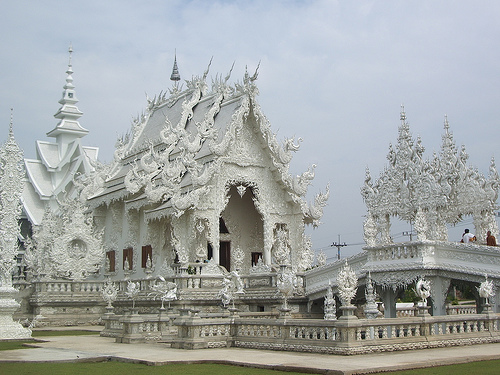
Wat Rong Khun, the White Temple. Image: majorbonnet [Flickr]
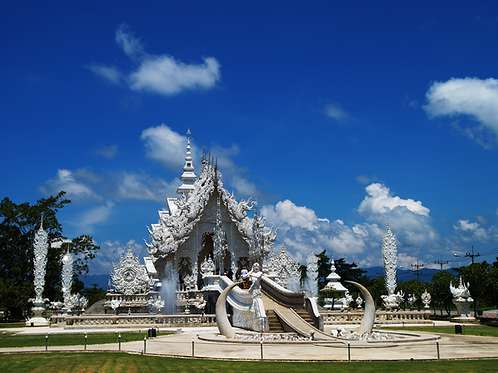
Wat Rong Khun, from a distance. Image: AraiGordai [Flickr]
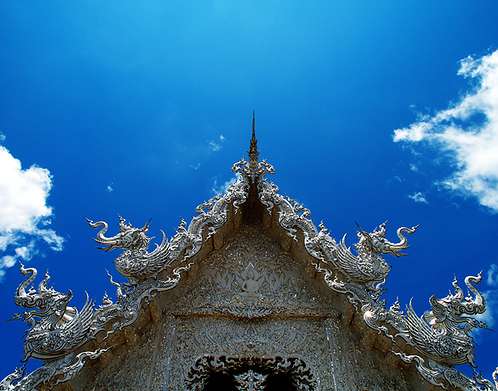
Details of the temple roof. Image: AraiGordai [Flickr]
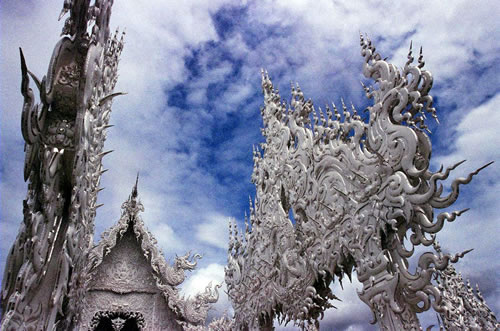
The ornately detailed arches. Image: Alicia Lim [Flickr]
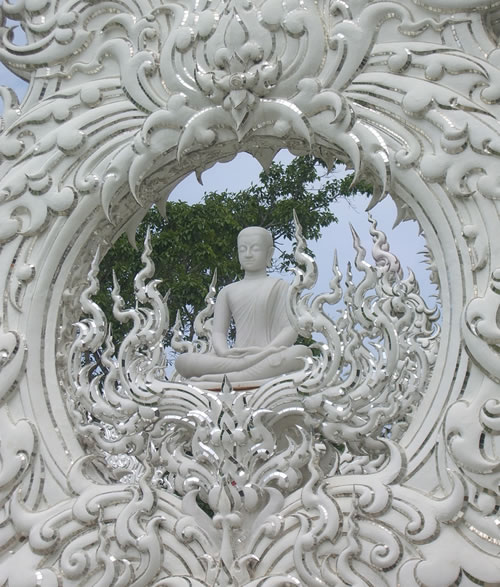
Buddha sculpture, gilded with mosaic mirrors. Image: majorbonnet [Flickr]
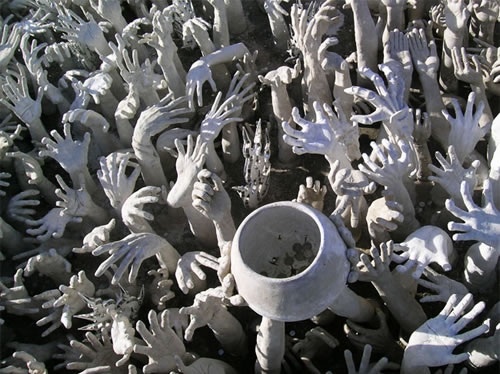
The hands of hell want your change. Image: pim [Flickr]
Nearly all the walls of the temple are covered in exquisite bas relief carvings, which narrate stories of Vishnu's incarnations, adventures of Hanuman the Monkey King, the Ramayana [wiki] epic and other legends.
Though not the biggest temple in Indonesia (Borobudur is larger - see below), Prambanan makes up in beauty and grace for what it lacks in size.
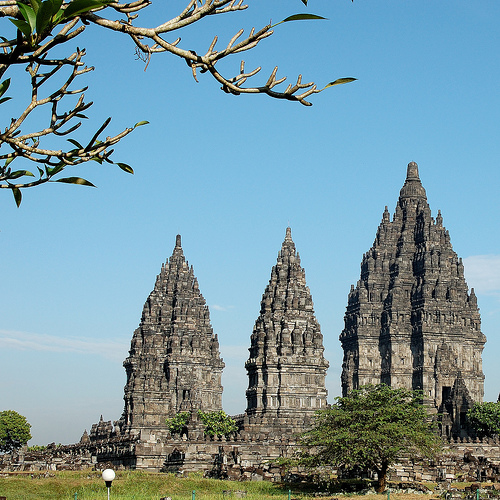
Prambanan's main complex. Image: Rosino [Flickr]
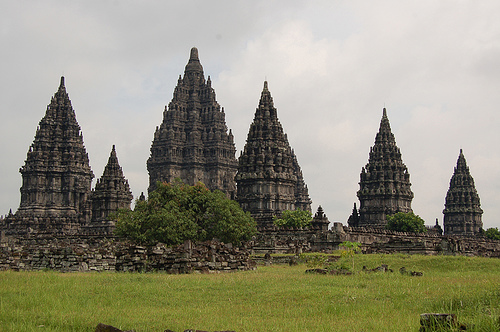
Six of Prambanan's eight main shrines. Image: kashikar [Flickr]
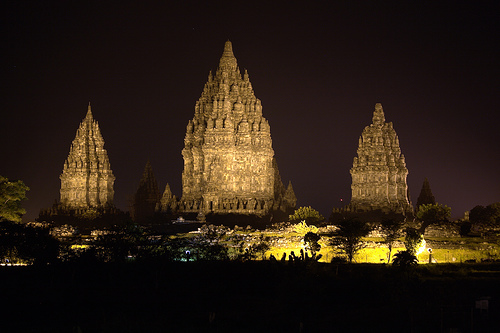
Prambanan at night. Image: Tierecke [Flickr]
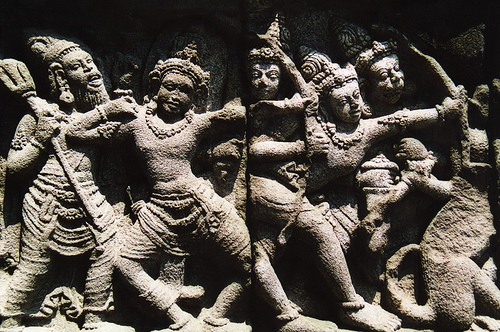
Bas-Relief at Prambanan. Image: Jungle_Boy [Flickr]
Now, when people say "golden temple" they usually mean that the structure is golden in color. But when it comes to the Shwedagon Pagoda, golden literally means covered in gold! In the 15th century, a queen of the Mon people donated her weight in gold to the temple. This tradition continues until today, where pilgrims often save for years to buy small packets of gold leafs to stick to the temple walls.
As if all that gold wasn't enough, the spire of the stupa or dome is covered with over 5,000 diamonds and 2,000 rubies (there's even a 76 carat diamond at the very tip!). And oh, the temple housed one of the holiest relics in Buddhism: eight strands of Buddha's hair.

Shwedagon Pagoda and its golden stupa. Image: Dust Mason [Flickr]
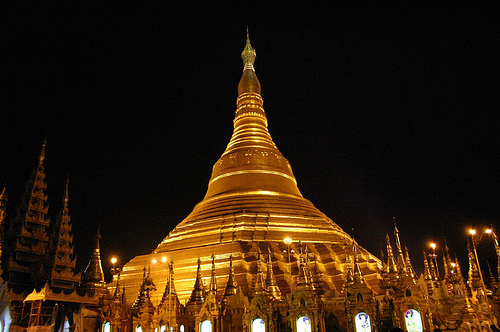
Shwedagon Pagoda at night. Image: M.Bob [Flickr]
The Temple's architecture is quite interesting: everything in the temple, which represents Heaven, is circular whereas the ground levels, which represent the Earth, are square.
More than a quarter of all people in the world belong to Eastern religions, which include Buddhism, Hinduism, Sikhism, and Taoism. These people worship in temples, which are architecturally as diverse as the religions are different from each other. From the ancient ruins of Ankor Wat to the distinctly modern Wat Rong Khun, there are hundreds if not thousands of amazing temples in the world.
I have long been fascinated by the temples and sacred sites of Eastern religions. After doing an article on some amazing churches from around the world (10 Divinely Designed Churches), it's only right that we do a follow up on the ten most fascinating temples in Asia. Here they are, in no particular order:
Tiger's Nest Monastery
Tiger's Nest Monastery, perched precariously on the edge of a 3,000-feet-high cliff in Paro Valley, is one of the holiest places in Bhutan. Legend has it that Guru Rinpoche [wiki], the second Buddha, flew onto the cliff on the back of a tigress, and then meditated in a cave which now exists within the monastery walls.The monastery, formally called Taktshang Goemba, was built in 1692 and reconstructed in 1998 after a fire. Now, the monastery is restricted to practicing Buddhists on religious retreats and is off-limits to ordinary tourists.

Image: Leo Palmer Photography

Image: Douglas J. McLaughlin [wikipedia]
Wat Rong Khun
Wat Rong Khun in Chiang Rai, Thailand is unlike any Buddhist temples in the world. The all-white, highly ornate structure gilded in mosaic mirrors that seem to shine magically, is done in a distinctly contemporary style. It is the brainchild of renowned Thai artist Chalermchai Kositpipat.Actually, the temple is still under construction. Chalermchai expects it will take another 90 years to complete, making it the Buddhist temple equivalent of the Sagrada Familia church in Barcelona, Spain!

Wat Rong Khun, the White Temple. Image: majorbonnet [Flickr]

Wat Rong Khun, from a distance. Image: AraiGordai [Flickr]

Details of the temple roof. Image: AraiGordai [Flickr]

The ornately detailed arches. Image: Alicia Lim [Flickr]

Buddha sculpture, gilded with mosaic mirrors. Image: majorbonnet [Flickr]

The hands of hell want your change. Image: pim [Flickr]
Prambanan
Prambanan is a Hindu temple in Central Java, Indonesia. The temple was built in 850 CE, and is composed of 8 main shrines and 250 surrounding smaller ones.Nearly all the walls of the temple are covered in exquisite bas relief carvings, which narrate stories of Vishnu's incarnations, adventures of Hanuman the Monkey King, the Ramayana [wiki] epic and other legends.
Though not the biggest temple in Indonesia (Borobudur is larger - see below), Prambanan makes up in beauty and grace for what it lacks in size.

Prambanan's main complex. Image: Rosino [Flickr]

Six of Prambanan's eight main shrines. Image: kashikar [Flickr]

Prambanan at night. Image: Tierecke [Flickr]

Bas-Relief at Prambanan. Image: Jungle_Boy [Flickr]
Shwedagon Pagoda
No one knows exactly when the Shwedagon Paya [wiki] (or Pagoda) in Myanmar was built - legend has it that it is 2,500 years old though archaeologists estimate that it was built between the 6th and 10th century.Now, when people say "golden temple" they usually mean that the structure is golden in color. But when it comes to the Shwedagon Pagoda, golden literally means covered in gold! In the 15th century, a queen of the Mon people donated her weight in gold to the temple. This tradition continues until today, where pilgrims often save for years to buy small packets of gold leafs to stick to the temple walls.
As if all that gold wasn't enough, the spire of the stupa or dome is covered with over 5,000 diamonds and 2,000 rubies (there's even a 76 carat diamond at the very tip!). And oh, the temple housed one of the holiest relics in Buddhism: eight strands of Buddha's hair.

Shwedagon Pagoda and its golden stupa. Image: Dust Mason [Flickr]

Shwedagon Pagoda at night. Image: M.Bob [Flickr]
Temple of Heaven
The Temple of Heaven [wiki] is a Taoist temple in Beijing, the capital of China. The temple was constructed in 14th century by Emperor Yongle of the Ming Dynasty (who also built the Forbidden City) as his personal temple, where he would pray for good harvest and to atone for the sins of his people.The Temple's architecture is quite interesting: everything in the temple, which represents Heaven, is circular whereas the ground levels, which represent the Earth, are square.
The Hall of Prayer for Good Harvest at the Temple of Heaven, Beijing.
Image: Saad Akhtar [wikipedia]
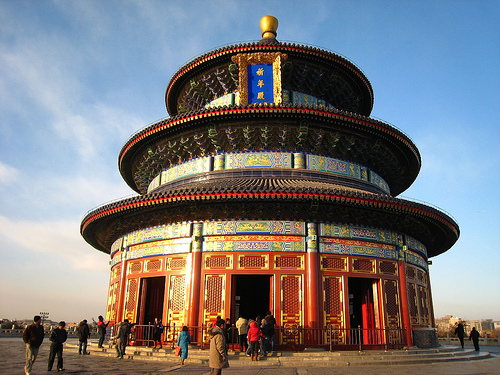
Close up of the Hall of Prayer for Good Harvest, Temple of Heaven.
Image: star5112 [Flickr]
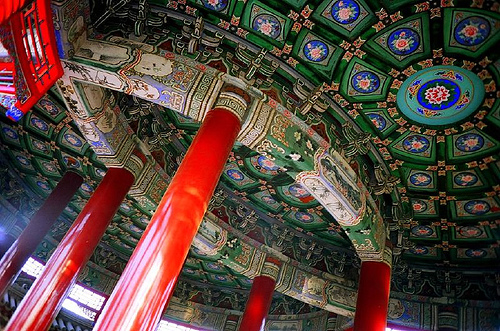
Ceiling of the Imperial Vault, Temple of Heaven. Image: Carol^-^ [Flickr]
Visitors to the Chion-in Temple must first pass through the largest gate in Japan: the two-story San-mon Gate. The temple bell is also a record setter: it weighs 74 tons and needs 17 monks to ring it during the New Year celebrations.
Another interesting feature of the Chion-in Temple is the "singing" floor of the Assembly Hall. Called a uguisu-bari or nightingale floor, the wooden planks were designed to creak at every footstep to alert the monks of intruders!
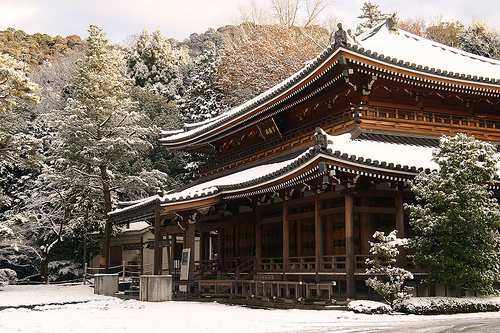
A building in the Chion-in Temple complex in winter time. Image: psychofish [Flickr]
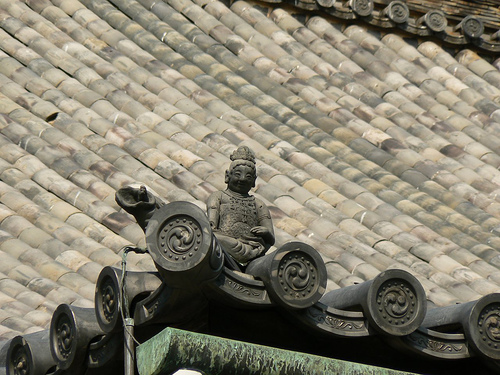
Details of the Chion-in Temple roof. Notice a feudal family's crest stamped on the roof tiles, as a symbol of their patronage. Image: kuribo [Flickr]
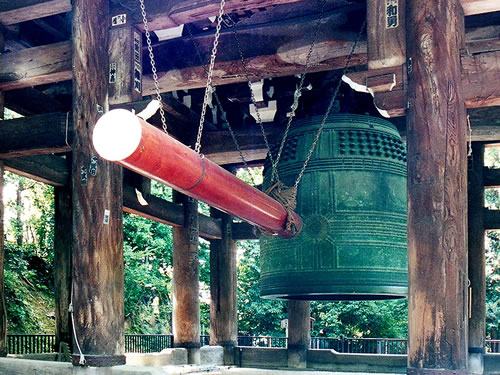
Chion-in's Temple Bell. Image: Richard Seaman
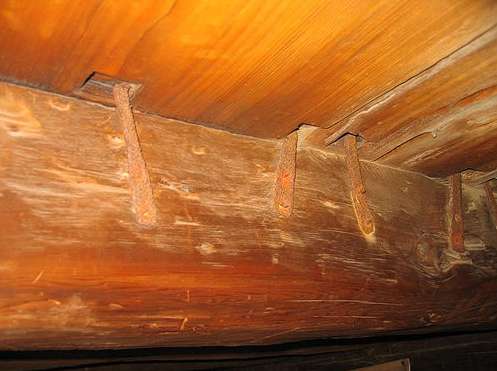
The Nightingale Floor construction. Image: rygriffin333 [Flickr]
Until today, no one knows for sure when and why it was built, nor the reason for its complete abandonment hundreds of years ago. Some scholars believe that Borobudur is actually a giant textbook of Buddhism, as its bas reliefs tell the story of the life of Buddha and the principles of his teachings. To "read," a pilgrim must make his way through nine platforms and walk a distance of over 2 miles.
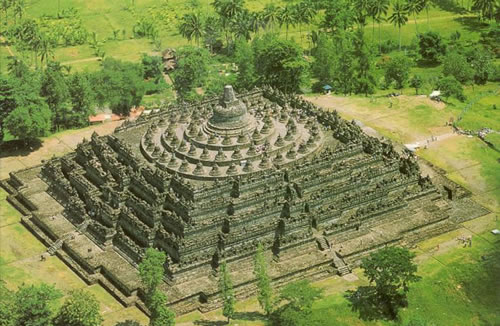
Aerial view of Borobudur. Image: Kenyon College
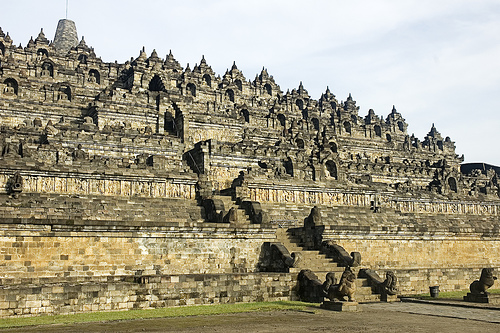
Image: hceebee [Flickr]
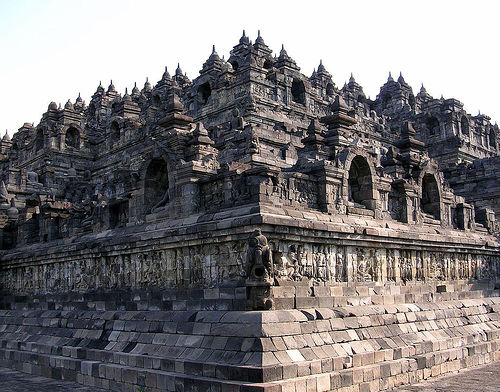
Image:elbisreverri [Flickr]
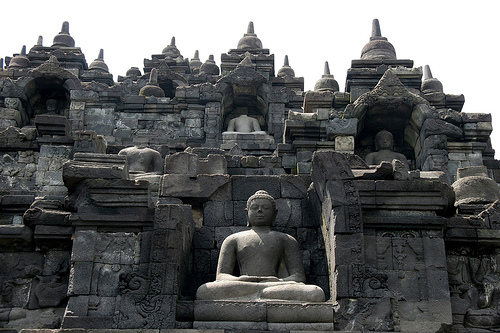
Image: susan catherine [Flickr]

Inside each of the lattice stupa is a Buddha statue. Image: Jin Aili [Flickr]
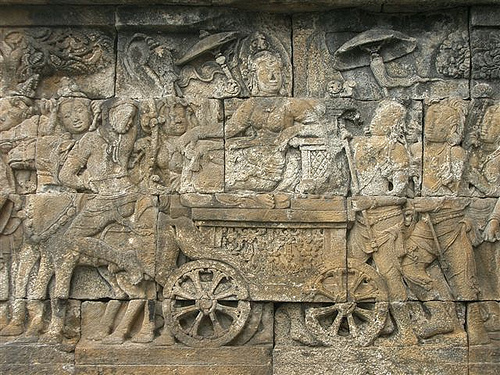
A bas relief in Borobudur. Image: lizamber [Flickr]
The site of the Temple began with a small lake that was so peaceful that even Buddha came there to meditate. Thousands of years later, Guru Nanak, the founder of Sikhism also lived and meditate by the lake.
Construction of the Golden Temple began in the 1500s, when the fourth Guru of Sikhism enlarged the lake that became Amritsar or Pool of the Nectar of Immortality, around which the temple and the city grew. The Temple itself is decorated with marble sculptures, gilded in gold, and covered in precious stones.

Golden Temple, from a distance. Image: Saurabh C [Flickr]

The Golden Temple of Amristar. Image: Saurabh C [Flickr]

The Golden Temple of Amritsar at night. Image: Saurabh C [Flickr]
The temple is dedicated to Vishnu, one of three Gods in Hinduism. Legend has it that a long time ago, a sage rested and put down a statue of Vishnu reclining on a great serpent. When he was ready to resume his journey, he discovered that the statue couldn't be moved, so a small temple was built over it. Over centuries, the temple "grew" as larger ones were built over the existing buildings.
The temple complex is massive: it encompasses an area of over 150 acres (63 hectares) with seven concentric walls, the outermost being about 2.5 miles (4 kilometers) long! The walls demarcate enclosures within enclosures, each more sacred than the next, with the inner-most enclosure is forbidden to non-Hindus.
The Temple of Srirangam is famous for its gopurams or entrances beneath colorful pyramids. The temple has 21 gopurams total, with the largest one having 15 stories and is nearly 200 feet (60 m) tall.
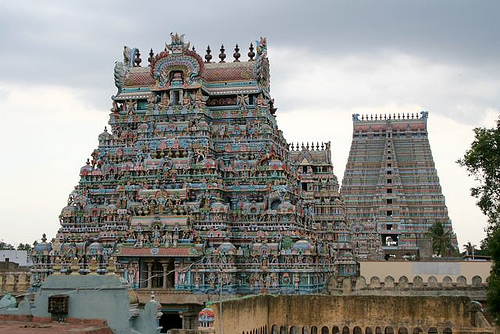
Temple of Srirangam, with its colorful gopurams. Image: licinivs [Flickr]
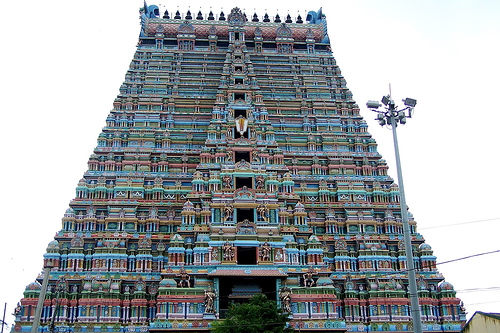
The largest gopuram of the Temple of Srirangam. Image: Subash Chandran [Flickr]
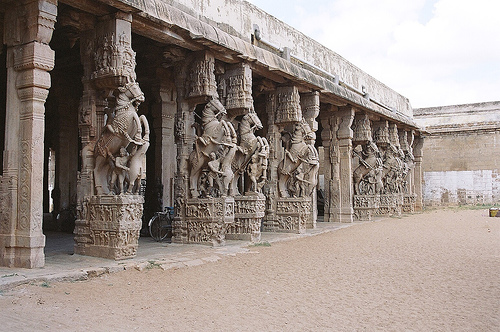
The carved pillars in the Srirangam Temple complex. Image: appaji [Flickr]
Angkor Wat [wiki] was built in the early 12th century in what is now Cambodia. The world famous temple was first a Hindu one, dedicated to Vishnu. In the 14th or 15th century, as Buddhism swept across Asia, it became a Buddhist temple.
The Western world's got a glimpse of Angkor Wat when a 16th century Portuguese monk visited the temple and eloquently described it as "of such extraordinary construction that it is not possible to describe it with a pen, particularly since it is like no other building in the world. It has towers and decoration and all the refinements which the human genius can conceive of." His words still rang true today.
Tourists visiting Angkor Wat usually also visit the nearby ruins of Angkor Thom and Bayon [wiki], two fantastic temples that serve as the ancient capital of Khmer empire.
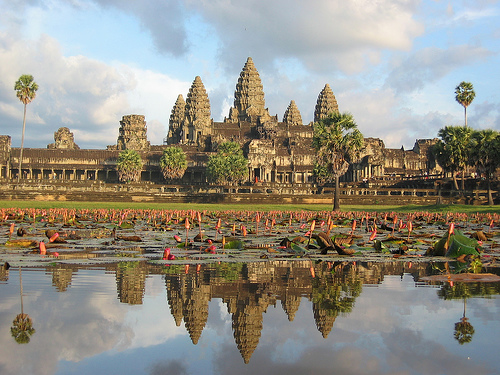
Angkor Wat. Image: jpslim [Flickr]
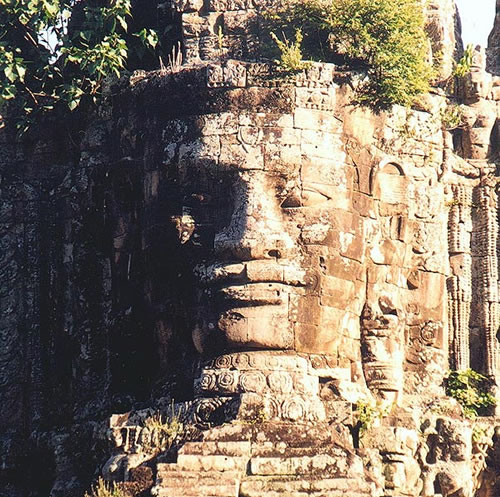
The face of Bodhisattva Avalokiteshvara at Angkor Thom.
Image: Manfred Werner [wikipedia]
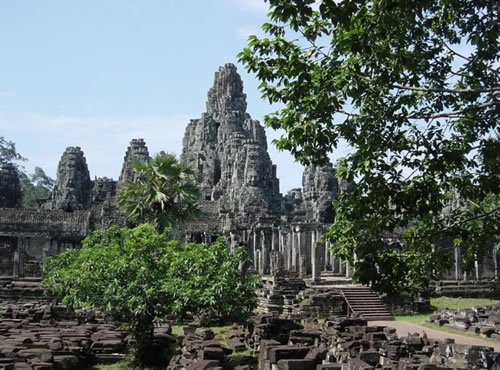
Bayon, which described by Maurice Glaize, an Angkor conservator of the 1940s, as "but a muddle of stones, a sort of moving chaos assaulting the sky"
Image: Charles J. Sharp [wikipedia]
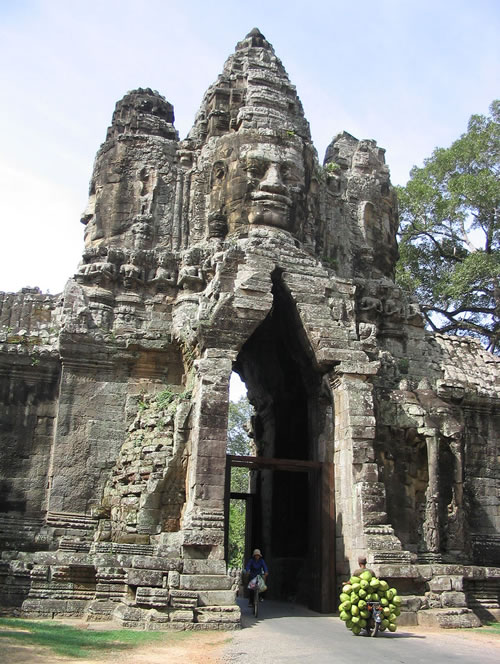
Entrance to Bayon. That man on the bike is carrying coconuts. Lots and lots of coconuts. Image:therefromhere [Flickr]
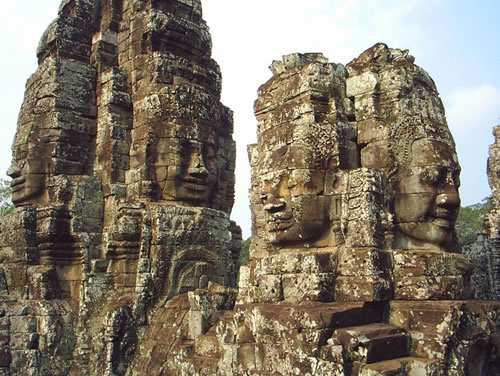
The faces of Bayon. Straight out of Indiana Jones, man!
Image: Henry Flower [wikipedia]
The Palace consists of two main buildings, the Potrang Karpo (White Palace) and Portrang Marpo (Red Palace). It was the chief home of the fourteenth and current Dalai Lama until he was forced to flee to India when China invaded Tibet in 1959. It is now a state museum.
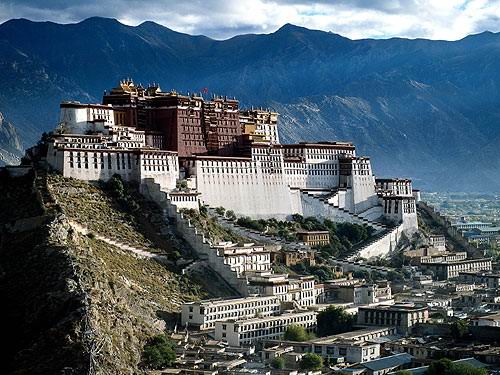
Potala Palace. Image: Press Club of Tibet
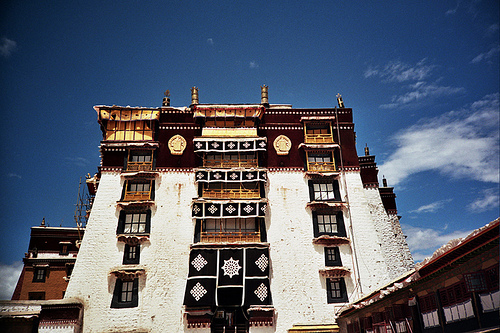
The White Palace. Image: vwsluk [Flickr]

Close up of the Hall of Prayer for Good Harvest, Temple of Heaven.
Image: star5112 [Flickr]

Ceiling of the Imperial Vault, Temple of Heaven. Image: Carol^-^ [Flickr]
Chion-in Temple
Chion-in Temple [wiki] was built in 1234 CE to honor the founder of Jodo (Pure Land) Buddhism, a priest named Honen, who fasted to death in the very spot. At one point in time, the complex had 21 buildings but due to earthquakes and fire, the oldest surviving building is from the 17th century.Visitors to the Chion-in Temple must first pass through the largest gate in Japan: the two-story San-mon Gate. The temple bell is also a record setter: it weighs 74 tons and needs 17 monks to ring it during the New Year celebrations.
Another interesting feature of the Chion-in Temple is the "singing" floor of the Assembly Hall. Called a uguisu-bari or nightingale floor, the wooden planks were designed to creak at every footstep to alert the monks of intruders!

A building in the Chion-in Temple complex in winter time. Image: psychofish [Flickr]

Details of the Chion-in Temple roof. Notice a feudal family's crest stamped on the roof tiles, as a symbol of their patronage. Image: kuribo [Flickr]

Chion-in's Temple Bell. Image: Richard Seaman

The Nightingale Floor construction. Image: rygriffin333 [Flickr]
Borobudur
In the 19th century, Dutch occupiers of Indonesia found a massive ancient ruin deep in the jungles of Java. What they discovered was the complex of Borobudur, a gigantic structure built with nearly 2 million cubic feet (55,000 m³) of stones. The temple has nearly 2,700 relief panels and 504 Buddha statues.Until today, no one knows for sure when and why it was built, nor the reason for its complete abandonment hundreds of years ago. Some scholars believe that Borobudur is actually a giant textbook of Buddhism, as its bas reliefs tell the story of the life of Buddha and the principles of his teachings. To "read," a pilgrim must make his way through nine platforms and walk a distance of over 2 miles.

Aerial view of Borobudur. Image: Kenyon College

Image: hceebee [Flickr]

Image:elbisreverri [Flickr]

Image: susan catherine [Flickr]

Inside each of the lattice stupa is a Buddha statue. Image: Jin Aili [Flickr]

A bas relief in Borobudur. Image: lizamber [Flickr]
Golden Temple
The Harmandir Sahib (meaning The Abode of God) or simply the Golden Temple [wiki] in Punjab, India is the most sacred shrine of Sikhism. For the Sikhs, the Golden Temple symbolizes infinite freedom and spiritual independence.The site of the Temple began with a small lake that was so peaceful that even Buddha came there to meditate. Thousands of years later, Guru Nanak, the founder of Sikhism also lived and meditate by the lake.
Construction of the Golden Temple began in the 1500s, when the fourth Guru of Sikhism enlarged the lake that became Amritsar or Pool of the Nectar of Immortality, around which the temple and the city grew. The Temple itself is decorated with marble sculptures, gilded in gold, and covered in precious stones.

Golden Temple, from a distance. Image: Saurabh C [Flickr]

The Golden Temple of Amristar. Image: Saurabh C [Flickr]

The Golden Temple of Amritsar at night. Image: Saurabh C [Flickr]
Vishnu Temple of Srirangam
The Temple of Srirangam (Sri Ranganathaswamy Temple [wiki]), in the Indian city of Tiruchirapalli (or Trichy), is the largest functioning Hindu temple in the world (Ankor Wat is the largest of all temple, but it is currently non-functioning as a temple - see below).The temple is dedicated to Vishnu, one of three Gods in Hinduism. Legend has it that a long time ago, a sage rested and put down a statue of Vishnu reclining on a great serpent. When he was ready to resume his journey, he discovered that the statue couldn't be moved, so a small temple was built over it. Over centuries, the temple "grew" as larger ones were built over the existing buildings.
The temple complex is massive: it encompasses an area of over 150 acres (63 hectares) with seven concentric walls, the outermost being about 2.5 miles (4 kilometers) long! The walls demarcate enclosures within enclosures, each more sacred than the next, with the inner-most enclosure is forbidden to non-Hindus.
The Temple of Srirangam is famous for its gopurams or entrances beneath colorful pyramids. The temple has 21 gopurams total, with the largest one having 15 stories and is nearly 200 feet (60 m) tall.

Temple of Srirangam, with its colorful gopurams. Image: licinivs [Flickr]

The largest gopuram of the Temple of Srirangam. Image: Subash Chandran [Flickr]

The carved pillars in the Srirangam Temple complex. Image: appaji [Flickr]
Angkor Wat, Angkor Thom, and Bayon
Last but definitely not least is the largest temple in history and the inspiration to countless novels and action movies of Hollywood: Ankor Wat.Angkor Wat [wiki] was built in the early 12th century in what is now Cambodia. The world famous temple was first a Hindu one, dedicated to Vishnu. In the 14th or 15th century, as Buddhism swept across Asia, it became a Buddhist temple.
The Western world's got a glimpse of Angkor Wat when a 16th century Portuguese monk visited the temple and eloquently described it as "of such extraordinary construction that it is not possible to describe it with a pen, particularly since it is like no other building in the world. It has towers and decoration and all the refinements which the human genius can conceive of." His words still rang true today.
Tourists visiting Angkor Wat usually also visit the nearby ruins of Angkor Thom and Bayon [wiki], two fantastic temples that serve as the ancient capital of Khmer empire.

Angkor Wat. Image: jpslim [Flickr]

The face of Bodhisattva Avalokiteshvara at Angkor Thom.
Image: Manfred Werner [wikipedia]

Bayon, which described by Maurice Glaize, an Angkor conservator of the 1940s, as "but a muddle of stones, a sort of moving chaos assaulting the sky"
Image: Charles J. Sharp [wikipedia]

Entrance to Bayon. That man on the bike is carrying coconuts. Lots and lots of coconuts. Image:therefromhere [Flickr]

The faces of Bayon. Straight out of Indiana Jones, man!
Image: Henry Flower [wikipedia]
Potala Palace
Potala Palace [wiki], built on top of the Red Mountain in Lhasa, Tibet, China was built by the first emperor of Tibet in 637 CE. The current palace was re-constructed in the mid-1600s by the fifth Dalai Lama.The Palace consists of two main buildings, the Potrang Karpo (White Palace) and Portrang Marpo (Red Palace). It was the chief home of the fourteenth and current Dalai Lama until he was forced to flee to India when China invaded Tibet in 1959. It is now a state museum.

Potala Palace. Image: Press Club of Tibet

The White Palace. Image: vwsluk [Flickr]
Jokhan Temple
Jokhan Temple [wiki] is the spiritual center of Lhasa and is considered the most important and sacred temple in Tibet. The temple was built in 642 CE and has since housed the single most venerated object in Tibetan Buddhism: a statue of Gautama Buddha [wiki], the founder of Buddhism.
The city of Lhasa has three concentric paths that pilgrims use to walk to Jokhang Temple. Many actually prostrate themselves along these routes in order to gain spiritual merit!
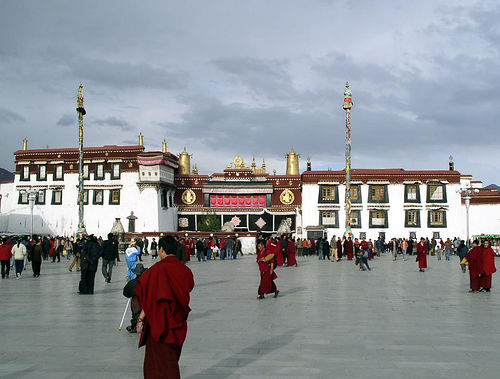
Jokhang Temple. Image: The boy with the thorn in his side [Flickr]
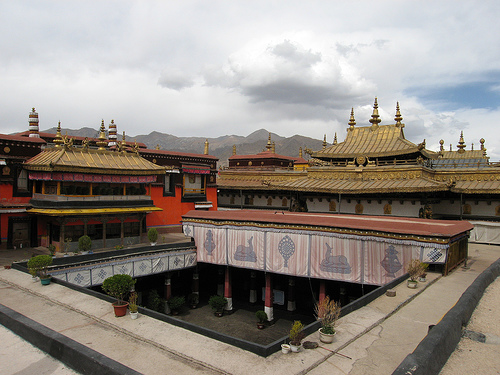
The courtyard of the Jokhang Temple. Image: polymerchicken [Flickr]
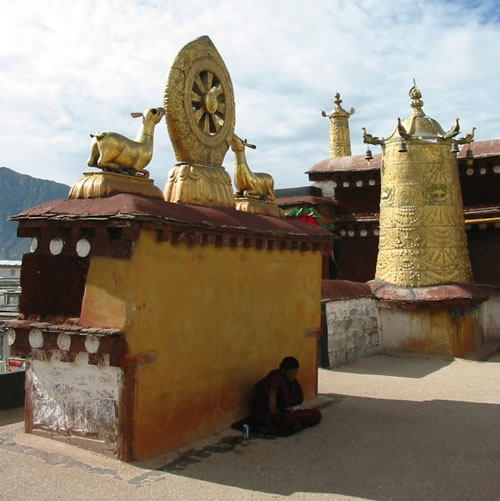
Two golden deers flanking a Dharma Wheel and a golden bell at the roof of Jokhang Temple. Image: satellite360 [Flickr]
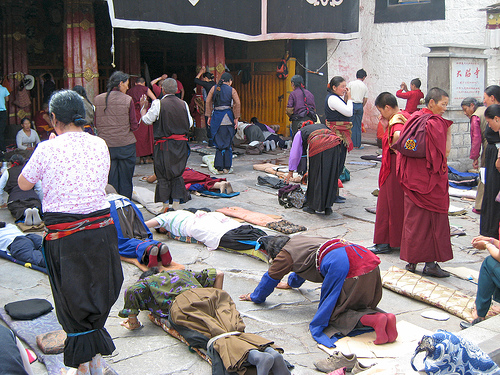
Pilgrims prostrate themselves in front of Jokhang. Image: thriol [Flickr]
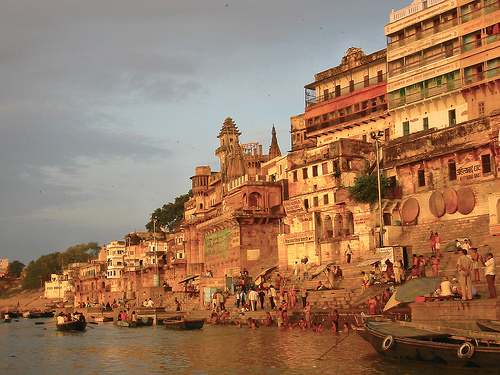
Sunrise at the Ganges River in Varanasi. Image: ironmanix [Flickr]
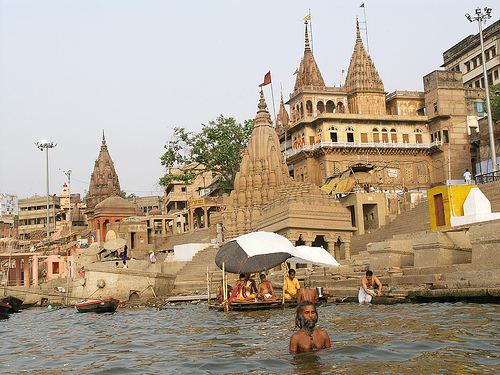
Temples are everywhere in Varanasi. Image: juicyrai [Flickr]
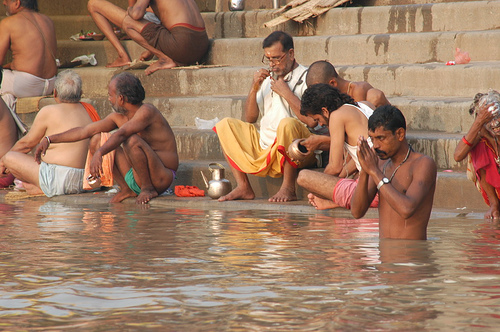
Pilgrims believe that bathing in the Ganges River will cleanse them of sins.
Image: Jackson Lee [Flickr]
The city of Lhasa has three concentric paths that pilgrims use to walk to Jokhang Temple. Many actually prostrate themselves along these routes in order to gain spiritual merit!

Jokhang Temple. Image: The boy with the thorn in his side [Flickr]

The courtyard of the Jokhang Temple. Image: polymerchicken [Flickr]

Two golden deers flanking a Dharma Wheel and a golden bell at the roof of Jokhang Temple. Image: satellite360 [Flickr]

Pilgrims prostrate themselves in front of Jokhang. Image: thriol [Flickr]
Varanasi
Varanasi in India is not a temple, but ais ctually a famous Hindu holy city, located at the banks of the Ganges River. It is, however, often called the "City of Temples," where almost every road crossing has a nearby temple. A center of pilgrimage (as many as a million pilgrims visit Varanasi each year), the city has links to Buddhism and Jainism as well.
Sunrise at the Ganges River in Varanasi. Image: ironmanix [Flickr]

Temples are everywhere in Varanasi. Image: juicyrai [Flickr]

Pilgrims believe that bathing in the Ganges River will cleanse them of sins.
Image: Jackson Lee [Flickr]
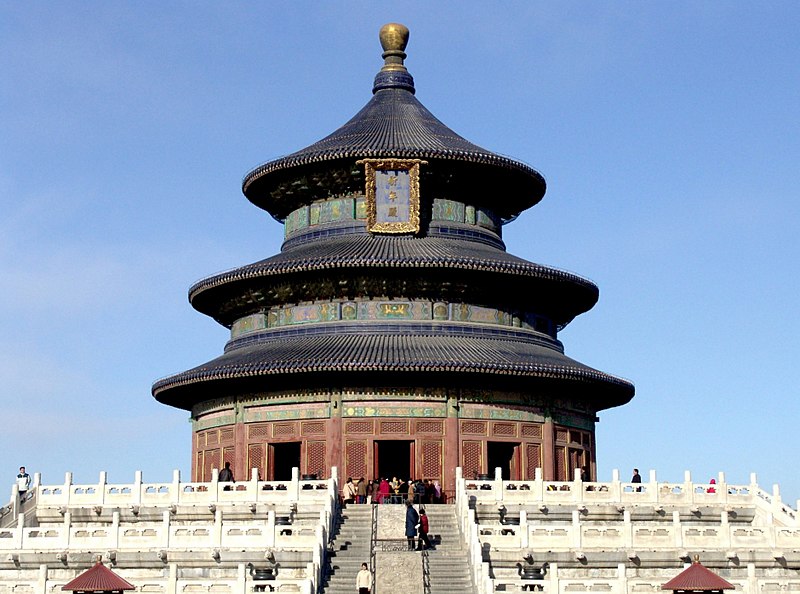




No comments:
Post a Comment